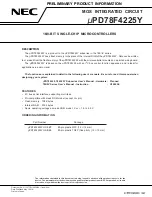
88
7679H–CAN–08/08
AT90CAN32/64/128
9.3.8
Alternate Functions of Port G
The alternate pin configuration is as follows:
The alternate pin configuration is as follows:
• TOSC1 – Port G, Bit 4
TOSC2, Timer/Counter2 Oscillator pin 1. When the AS2 bit in ASSR is set (one) to enable asyn-
chronous clocking of Timer/Counter2, pin PG4 is disconnected from the port, and becomes the
input of the inverting Oscillator amplifier. In this mode, a Crystal Oscillator is connected to this
pin, and the pin can not be used as an I/O pin.
• TOSC2 – Port G, Bit 3
TOSC2, Timer/Counter2 Oscillator pin 2. When the AS2 bit in ASSR is set (one) to enable asyn-
chronous clocking of Timer/Counter2, pin PG3 is disconnected from the port, and becomes the
inverting output of the Oscillator amplifier. In this mode, a Crystal Oscillator is connected to this
pin, and the pin can not be used as an I/O pin.
• ALE – Port G, Bit 2
ALE is the external data memory Address Latch Enable signal.
• RD – Port G, Bit 1
RD is the external data memory read control strobe.
• WR – Port G, Bit 0
WR is the external data memory write control strobe.
Table 9-21.
Port G Pins Alternate Functions
Port Pin
Alternate Function
PG4
TOSC1 (RTC Oscillator Timer/Counter2)
PG3
TOSC2 (RTC Oscillator Timer/Counter2)
PG2
ALE (Address Latch Enable to external memory)
PG1
RD (Read strobe to external memory)
PG0
WR (Write strobe to external memory)
















































